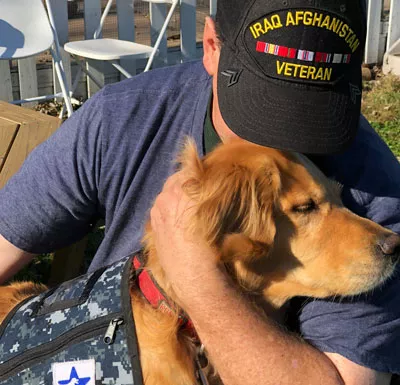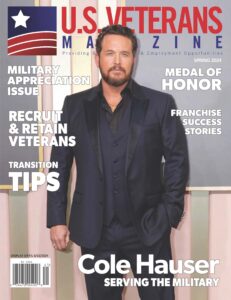According to a new review of evidence-based studies, military veterans who have post-traumatic stress disorder (PTSD) benefit from reduced symptoms and enhanced trauma treatments when they partner with assistance dogs and help with their training.
Seven scientific studies published in peer-reviewed journals found that assistance dog training and partnering produced “moderate-to-significant” lowering of PTSD symptom scores in line with those reported in gold-standard trials of trauma interventions supported by the U.S. Department of Veterans Affairs.
The studies, carried out over the past five years, looked at a range of programs, from partnering veterans with fully-trained assistance dogs to teaching veterans how to train assistance dogs. All seven studies found reduced PTSD symptoms after participants completed service dog handling instruction. Two others, which used follow-up measures, found a long-term reduction in symptoms.

“Assistance dogs improve the lives of countless thousands of veterans around the world by helping with practical tasks, enhancing independence and boosting well-being, dignity and confidence,” said Chris Diefenthaler, executive director of Assistance Dogs International (ADI). “These studies indicate that properly trained assistance dogs are both life-saving and life-changing for veterans suffering from PTSD. They are proof that assistance dogs have a major role to play in the treatment, rehabilitation and support of military veterans with severe combat trauma.”
Eleven assistance dog programs across the U.S. including eight accredited by ADI — participated in the studies carried out by behavioral scientists, military psychologists, public health experts and social workers. Researchers reported that “veterans benefit significantly from dog ownership in combination with a structured dog training program. Not only do they experience significant decreases in stress and post-traumatic stress symptoms, but [they also] experience less isolation and self-judgment while also experiencing significant improvements in self-compassion.”
One study found “a statistically significant decrease in PTSD and depression symptoms…participants reported significant reductions in anger and improvement in perceived social support and quality of life.” In another study, researchers working with veterans being treated for chronic severe combat trauma used eye-tracking technology to measure the psychological effect of training a young assistance dog. The more time veterans spent in close contact with the dog, the less time they spent looking at threatening imagery, and they paid more attention to “pleasant” images.
In four studies that utilized control groups, symptoms of the assistance dog participants were reduced more than those of the control group, and few improvements were found in the treatment-only comparison groups.
“The scientific evidence is conclusive,” said Rick Yount, founder and executive director of ADI member Warrior Canine Connection. “These seven scientific examinations provide the long-awaited evidence that assistance dogs are both popular and effective at reducing trauma symptoms and improving the quality of life for our veterans. They also indicate that partnering with an assistance dog can enhance the perception of standard trauma treatment. PTSD is projected to remain a chronic and debilitating condition for thousands of veterans. It is imperative that assistance dogs for veterans with PTSD be fully integrated into military and veteran trauma care.”
Source: Assistance Dogs International



